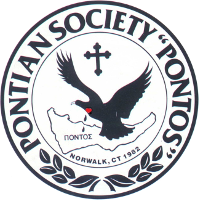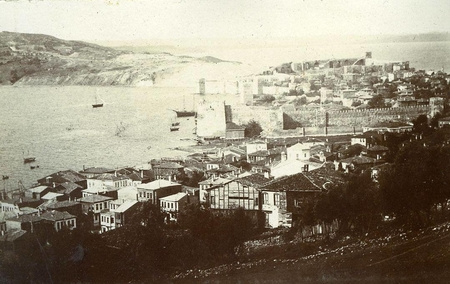The most famous cities of Pontus were founded or re-established by the colonists of the wider Greek area, who were the connecting links between the metropolis and the new homelands. These cities developed rich cultural and economic activity, either in connection with the mother city, or independently. The first colonists were the Ionians from Miletus, followed by the Megarians, the Phocaeans, the Athenians and others. All of them, also known as the Pontic Greeks, brought with them the sacred fire from the hearth of the metropolis, led by the settler, a prominent citizen who often emerged as a hero, a defender of the rights of the colony. The Pontic Greeks, from the 8th century BC, began to develop close relations with the natives of Pontus and were with them, the dough from which the new Greek homelands were formed.
SINOPE
It was re-founded by the Ionians of Miletus in the early 8th century BC and was the first Greek colony in Pontus. Later, the Sinopeans founded, according to Herodotus and Xenophon, their own colonies: Trabzon, Kerasounta and Kotyora. The Athenian politician Pericles visited the city, established a democratic government and settled 600 Athenian citizens there. The famous Cynic philosopher Diogenes was born in Sinope in the 4th century BC in 183 BC the city became the capital of the kingdom of Pontus; Mithridates VI Eupator was born there. In 70 BC. fell into the hands of the Roman general Lucullus, who burned most of it. A few years later, the city became part of the Roman Empire. Synoptic settlers founded Trabzon and Kerasounta in antiquity. In Byzantine times, Sinope was an important port and place of Commerki (imperial administrative control service of trade). During the Arab wars he became the target of Arab invasions. In 1081 it was conquered by the Seljuks, but Alexios I the Great Komnenos recaptured it. Historical sources inform that the city was the seat of a theme, a prosperous shopping center with a rich treasury, and possibly also operated a mint. Sinope remained for a short time under the rule of the Great Komnenos (1204-1214, 1254-1265), but then came under full control of the Turks.
 AMISOS (SAMPSOUNTA)
AMISOS (SAMPSOUNTA)
It is a large city of Pontus and was colonized by the Sinopeans around the middle of the 8th century BC. It also became the capital of Pontus and there Mithridates VI built his palaces.
The ancient city is very close to today; is about 3 km away. It was the homeland of the mathematicians Demetrius and Dionysodorus as well as the scholar Tyrannion, who was a teacher of Strabo.
In medieval times, Amisos took the name Samsunda.
Prominent place in the historical memory is occupied by the village of Kavak, 48 km from Amisos. In June 1921, the Turks shot 701 Greeks there from the exiles of the first mission, because it was considered that they participated in the establishment of the independent republic of Pontus.
In Kavak, the Turks gathered the Greek musicians of Amisos and ordered them to play the national anthem of Turkey. However, the heroic Pontians played the Greek national anthem, so the Turks killed them all and threw them into a dry river. In the evenings they would gather the Greeks they were arresting and after killing them they would throw their bodies in the river. According to tradition, blood flowed in this river instead of water.
 Trebizond
Trebizond
“Trebizond the city, the most ancient city and of all the excellent ones. The excellent city at East.” This is what Ioannis Eugenikos calls it in his writing Praiseworthy Expression of Trebizond. The family of K.P. Cavafy also came from this area (as Iraklis Apostolidis had found and he had told his son Reno). The Alexandrian poet was inspired by the Pontian city, he was in pain and wrote “Parthen”. But more than anything else, I was most touched by the song of Trabzon with its strange language and the sorrow of the Greeks of those far away who may have always believed that we would still be saved.
Trabzon was colonized by the Sinopeans in 756 BC. Pausanias notes that the inhabitants of the Arcadian Trabzon had also settled there. According to Xenophon, the people of Trabzon hosted the Myrians as brothers for 30 days, gave them food and wine, made sacrifices in their honor and organized sports and horse races. Xenophon calls Trabzon a Greek city: From here two stations passed, seven parasangas and came to the sea, in Trabzon, a Greek city, inhabited in the Black Sea, a colony of the Sinopeans. The Myrians camped southeast of the city, on the hill Mithrio (400-401 BC).
Trabzon was the capital of the Komnenian Empire (1204-1461) with the first emperor Alexios Komnenos and the last David Komnenos. The city was conquered in 1461 by Muhammad II the Conqueror and became a field of indescribable massacres, deportations and persecutions. Many Christian children became, by force, janissaries, holy temples became mosques and the palaces of Komnenos became the house of the Turkish commander. Byzantine monuments abound in the city and many Byzantine churches survive: Agia Sophia (1260), Agios Eugenios (great martyr, patron saint of the city), Agia Anna (6th – 7th century), Agios Filippos, Panagia Theoskepastos and all of Panagia Chrysokefalou. Famous is the monastery of Panagia Soumela (386 AD) which is 54 km from the city.
The spiritual beacon of Pontus was the eponymous Tutoring Center of Trabzon, which was founded in 1682 by Pontius Sevastos Kyminitis and operated, with insignificant holidays, until 1923.
 KERASOUS
KERASOUS
Xenophon was the first to write about Kerasounta, praising the hospitality of the people of Kerasountia to the Myrians. A Greek city, it was founded in the 7th century BC by the Sinopeans. Kerasous, like the other cities of Pontus, was independent until the kingdom of Mithridates was founded. King Farnakis named it Farnakia and this name was maintained until the overthrow of the kingdom of Pontus by the Romans. During the Roman rule, the city maintained its autonomy as well as its ancient name Kerasos. This, according to one version, comes from the word Keras (Horn) because of its shape and according to another version from the tree Kerasia (cherry tree). Inscriptions from Roman times are preserved, such as brass coins of the emperors Hadrian and Aurelius, which bear on one side the name of the emperor and on the other the word Kerasountia. In Byzantine times the city belonged to the province of Polemonia Pontus and later to the province of Chaldia, with Trabzon as its capital.
Kerasous, due to its strategic position, was the target of conquering aspirations of various tribes. In 1300, during the reign of Alexius II of Komnenos, a large army of Turkish tribes, led by Kustoyan, captured the city, but Alexios, returning from Trabzon, fought a deadly battle, captured Kustoyan and captured much of his army. The Turks besieged the city in 1300. It was conquered in 1461 by Muhammad II the Conqueror. Kerasounta, a city with a long naval tradition, had the title of “Nymph of Pontus”. Inextricably linked to Kerasounta is the name of the lifelong mayor of Georgios Konstantinidis. He was a very capable, active, and dynamic man. With an imperial order he received the title of pasha and became known in history as Captain George Pasha. Kerasounta was one of the most important cities of Pontus and from a very early age it became an independent metropolis. During the first Ecumenical Council of Nicaea, 325 AD, the name of Gregory as bishop of Kerasounta is mentioned.
Kerasous, a city in the Black Sea, was a colony of Sinope. An important commercial port in the Byzantine years and the seat of Commerki (imperial administrative control service of trade). Kerasounta mainly exported clothes and alum, while there was also a hazelnut production center. During the years of the Empire of the Great Komnenos, the city was the target of Turkoman raids. Its importance for the empire is shown, among other things, by its fortifications. In the ecclesiastical hierarchy, Kerasounta is witnessed from the 5th century as the Diocese of Neocaesarea, while in the 11th century it was promoted to a metropolis without existing dioceses.
 AMASEIA
AMASEIA
Ancient city of Pontus and one of the few that kept its name unchanged from antiquity until 1922. The ancient geographer and historian Strabo (63 BC – 23 AD) was from Amasia, a coastal city of Pontus , which is crossed by the river Iris. Strabo writes about his homeland (Geographically, Book IB, paragraph 547, verse 15): The Iris river has its sources in this Pontus, flowing through the city of the Comans […] returns to the north [.] Then makes a turn to the east again, accepting the waters of Skylakos and other rivers and flows rapidly near this wall of Amasia, my homeland, which is a fortified city. (Translated by AS Arvanitopoulou). Amasya was the capital of the Mithridates until 183 BC. The city has the most ancient monuments in Pontus. In its rocky mountains there are caves that are nothing but the looted tombs of the Mithridates. Ancient Greek finds abound in her Museum. It is about 70 km from Amisos and the location where it is built has made it a natural fortress. It is surrounded by steep and inaccessible mountains, and its climate is healthy. The whole surrounding area was overgrown with vines, fruit trees and all kinds of vegetables. Its main products were cereals, the famous okra, the famous plums and the delicious apples. The arts and trade were in the hands of the Greeks. Amasia can not be violated by any other city of Pontus in antiquities (ancient monuments). The royal tombs carved in the rocks are of great archaeological interest.
In 70 BC. Amasya was conquered by the Romans and submitted to General Louloudos, while in 63 BC. became one of the eleven provinces founded in Pontus by Pompey. During the years of Byzantine rule, Amaseia was the capital of the province of Hellenopontos, while it was one of the main commercial centers of the region. In 529 AD It was almost completely destroyed by a strong earthquake, but was rebuilt during the reign of Justinian.
In the 11th century the city fell to the Seljuk Turks. Great Pontians were convicted and later martyred on the charge that they were fighting with the guerrillas for Pontic independence. In the central square of the city, in September 1821, the Turks hanged 174 Greeks of Pontus.
At the beginning of the 20th century, 155,000 Greeks lived in the region of Amasia and there were 325 schools with 10,000 and 565 teachers. The last metropolitan of Amaseia was Germanos Karavangelis (1866-1935), known for his national activism.
SOURCE: kotsari.com

